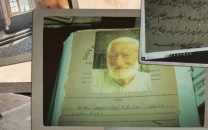A fistful of spice
Sheetal has toured with Cirque du Soleil, performed with the National Dance Ensemble of Ghana, and acted on Broadway.

A fistful of spice
Choreographed, written, directed and performed by Sheetal Gandhi, Bahu-Beti-Biwi (daughter-in-law, daughter, wife) is a solo contemporary dance performance which premiered in Philadelphia in February of this year. Sheetal explores her cultural heritage as a 21st-century Californian whose life is still shaped by age-old Indian traditions.
Sheetal has toured with Cirque du Soleil, performed with the National Dance Ensemble of Ghana, and acted on Broadway. She completed graduate school in 2009, where she came across the ‘grinding song’, an English translation of a Punjabi folk song and started toying with the idea for this performance.
Growing up in the San Francisco bay area, Sheetal would visit Rajasthan and part of the inspiration for this performance was shaped by her visit to India at the age of 17 years when her relatives shared stories about the trials of being newly married. “What also interested me were the women’s folk songs. Women can’t openly express themselves so it comes out in songs,” she says, “My character has a choice but even if you have the power of choice, you have to go through so many things. The modern woman still has the burden of making choices.
In my performance, the modern woman thinks about the boyfriend she broke up with because he loved his cat more than he loved her. On the other hand, the woman from the village does not have so many choices. But look at the similarity between both of them. We are all trying to find a way to feel free.”
The performance is a hybrid of many forms. While the footwork is from north India, Sheetal also incorporates jazz, ballet, West African and modern dance, purposefully assimilating different motifs and symbols into her performance. “The movement is dependent on the character and what serves the narrative,” she explains, “while telling the story of my aunty, I make a bee with my hands, symbolising freedom but then pulling it in by the constraints.”
Sheetal assumes various identities in the performance, while all of them are different, she presents them with a comic and sometimes a bizarre twist, with one merging into the other through her dance movements. Sheetal not only dances but also sings — that too live and in two languages: English and Marwadi (from the northwestern state of Rajasthan). Her performance of the daughter in law is the most powerful one. The character has very strong feelings about not being able to show her face and she struggles with not being allowed to wear the clothes she wants to wear.
“In Rajasthan you have to wear a sari and the human spirit is being confined! It is heartbreaking to see women who can reveal only their eyes in public,” she says. The daughter starts by questioning her mother. “Why can’t I Ma? Why can’t I wear a tank top?” As she sings these lyrics she removes the blouse of her sari to reveal a white tank top. She continues. “It is just an armpit! Tank top. Why not?” Thus the audience watches a transformed Sheetal in a white tank top and shorts while the black sari lays cast aside on the ground. “My mom used to tell me. You cannot wear a tank top in my house,” she explains “While at the same time, my brother was getting teased in India for wearing tiny shorts, and was called jadiwala.”
Next Sheetal transforms herself into the grandmother by wearing a sari wrapped around her head and tying her feet while still wearing a tank top and shorts. As she stumbles around on stage, she complains how her daughter’s modern ideas clash with her own. “As I was practicing my dance, the fabric wrapped around and got caught in my feet and I felt I became an older woman with a hunched back,” Sheetal explains, “the sari also becomes a symbol, when my feet are bunched together; it is the trapping of tradition.”
The character of the grandmother is based on what Sheetal’s mother said to her over the years but when her mother watched the performance, she didn’t know where Sheetal got her inspiration. “She is amazed at how this performance moves people the way it does. The specific stories that touch people are all connected to me. I have experienced these stories sometimes through my own experiences and sometimes through other people,” Sheetal explains.
Sheetal says that her performance tries to explain the similarities between people. “If you understand one person’s pain and struggle, you can understand the pain and struggle of others. The human spirit must not be suppressed,” she says, “Being a modern woman, and having my roots from Rajasthan. These are the struggles I encounter; it is neither good nor bad but just a part of my reality.”
Published in The Express Tribune, Sunday Magazine, April 1st, 2012.



1733130350-0/Untitled-design-(76)1733130350-0-208x130.webp)















COMMENTS
Comments are moderated and generally will be posted if they are on-topic and not abusive.
For more information, please see our Comments FAQ